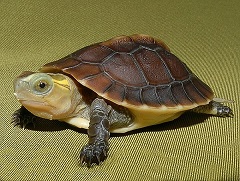Chinese Box Turtle (Cuora flavomarginata)
Classification: Introduced Species - While the Chinese Box Turtle has been seen and identified in the state of Texas, there are no records of any breeding populations. Sightings of this species are most likely of released or escaped pets that were imported for the pet trade.
Description: C. flavomarginata, Chinese Box Turtles (also called Yellow Margined Box Turtles) have a highly domed shell, the carapace and plastron of which are a dark brown with a cream-yellow stripe on the vertebral keel. The edge of the plastron is lightly pigmented due to the marginal scutes' and plastral scutes' lighter pigmentation near their edges. The skin on the limbs is brown, while the top of the head is pale green. Each side of the head has a yellow line extending from behind the eye backward. The skin beneath the head and between the limbs is a lighter pinkish color.
The name box turtle refers to C. flavomarginata'sability to bring the plastron to the edges of the carapace. This is enabled by a hinge on the plastron and ligaments connecting the carapace and plastron, which allows for limited movement. The forefeet have five claws, while the rear have four.
The external difference between male and female C. flavomarginata is slight. Males have a broader tail than females that is almost triangular in shape.
Habitat: Chinese box turtles live in areas with wet winters and hot summers. Their habitats are highly variable because these turtles are semi-aquatic. They spend much time on land in hilly, dense evergreen forests, low elevation grass lands, and in aquatic systems such as rice patties, streams, and rivers. During the winter these animals can be found hibernating under logs, undergrowth, thick leaves, and even in abandoned burrows. Habitats vary with reproductive state and season. Reproductive females, from April to July, are found in evergreen forest edges and from August to March, they are found in evergreen forest interiors. Females that aren't reproducing are found in evergreen forest interiors.
Range: It has been introduced into the San Antonio, Texas area. C. flavomarginata is found in Central China: Hunan, Henan, Anhui, Hubei, Chongqing, eastern Sichuan, Zhejiang & Jiangsu provinces (generally along the Yangtze drainage). It is also found in Taiwan and Japan, specifically the Ryukyu Islands, Ishigaki, and Iriomote.
Found in these States:
TX
Diet: Yellow-margined box turtles are omnivorous. In the wild they eat snails, slugs, worms, berries, and leaves. In captivity they are fed a similar diet, along with vegetables and cat food. Though cat food has been proven to have too much fat in it. Sheep bones, with the fat removed are also fed to the turtles for a good source of calcium.
Reproduction: Yellow-margined box turtles or Chinese Box Turtles mate year round, but most mating activity is from November through March. Males normally breed with more than one female throughout the breeding year. Copulation takes approximately 10 minutes.
Before nesting, females spend much of their time in open, sunny areas to keep their body temperatures up and accelerate egg development. Then nesting occurs during the summer months, May through September. The clutch is laid in shaded, soft, damp sand or soil. There can be 1 to 4 eggs per clutch and a possibility of many clutches per season. In total there are 4 to 9 eggs laid. The eggs are 1.5 to 2 inches long by 0.5 to 1 inch wide and weigh 11 to 18.5 g. The time from mating to hatching is anywhere from 68 to 101 days. Hatchlings weigh between 8 and 13 g at hatching.
Status: Yellow margined box turtle populations have declined in various areas. This has been caused by habitat destruction (land development and agriculture), over harvesting for human consumption and traditional Chinese medicine, and also harvesting for the pet trade. Populations are now protected in Taiwan and Japan.
Subspecies: None in our Range. Unknown as to which subspecies has been identified in Texas.
»» Kingdom: Animalia - Animals
»» Phylum: Chordata - Chordates
»» Subphylum: Vertebrata - Vertebrates
»» Class: Reptilia - Reptiles
»» Order: Testudines - Turtles & Tortoises
»» Family: Geoemydidae - Leaf Turtles
»» Genus: Cuora
»» Species: Cuora flavomarginata - Chinese Box Turtle
»» Subspecies: None
This article uses material from the Wikipedia article "Chinese Box Turtle", which is released under the Creative Commons Attribution-Share-Alike License 3.0. Content may have been omitted from the original, but no content has been changed or extended.
|







